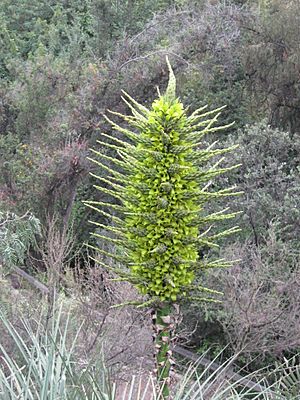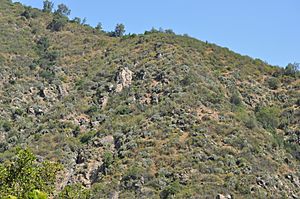Puya chilensis facts for kids
Quick facts for kids Puya chilensis |
|
|---|---|
 |
|
| Scientific classification | |
| Genus: |
Puya
|
| Species: |
chilensis
|
The Puya chilensis is a unique plant that grows on dry hillsides in Chile. It's a type of bromeliad, which is a family of plants that includes pineapples! This plant is known for its interesting looks and a surprising nickname.
What it Looks Like
This plant is an evergreen perennial, meaning it stays green all year round and lives for many years. It grows in big, thick clumps of grey-green leaves that look like straps. The edges of these leaves have sharp, hooked spines.
When it flowers, it sends up tall spikes, sometimes as high as 2 meters (about 6.5 feet)! The green or yellow flowers on these spikes look a bit like a medieval "morning star" weapon, which was a club with spikes.
Puya chilensis grows slowly. It can take 20 years or even more for a plant to flower for the first time! Over time, it can spread and cover large areas by sending out new shoots from its base.
The spines on the leaves point outwards. Scientists think these spines might help protect the plant by stopping animals from reaching its center. This plant has even earned the nickname "sheep-eating plant." This is because some people believe that if sheep or birds get tangled in its sharp spines and die, the plant might get nutrients from their bodies as they break down nearby. However, this idea has not been fully proven by scientists. If it were true, it would make Puya chilensis a protocarnivorous plant, meaning it's partly carnivorous but doesn't actively trap or digest prey like a Venus flytrap.
People in Chile also use the strong fibers from the leaves of Puya chilensis to weave tough fishing nets.
Where it Lives

You can usually find Puya chilensis growing on the dry hillsides of the Andes mountains in Chile. It likes sunny, north-facing slopes in areas called matorral, which are types of shrublands. These plants grow at heights of about 300 to 1000 meters (about 980 to 3,280 feet) above sea level.
Protecting the Plant
Good news! Puya chilensis is not currently considered an endangered plant. It's even grown in gardens and plant collections around the world.
However, in its natural dry home, these plants can catch fire easily. Fires, often started by people, can cause a lot of damage. Also, land being cleared for building or farming is becoming a bigger problem for these plants.
See also
 In Spanish: Puya chilensis para niños
In Spanish: Puya chilensis para niños
Images for kids










